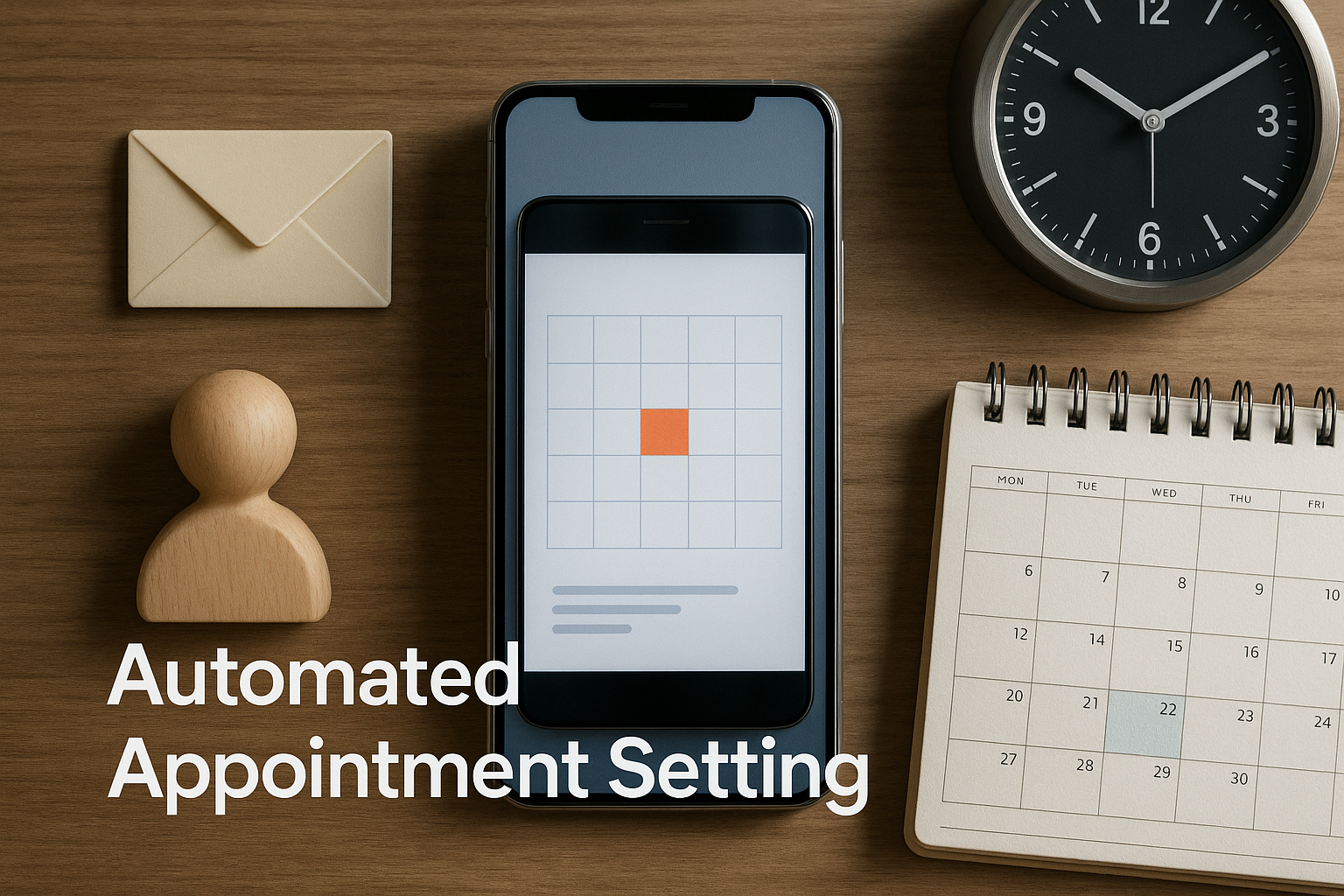Automated appointment setting makes scheduling easier, faster, and stress-free for businesses of all sizes.
Some work disappears without anyone noticing. Scheduling is one of those things. It feels small at first, a quick reply here, a follow-up there, but it slowly piles up. And suddenly, half the day is gone, spent juggling calendars instead of moving forward. It happens in offices, in small businesses, and even inside teams that swear they’re “organized enough.”
That’s why the shift toward automated appointment setting doesn’t feel loud or dramatic. It feels more like a quiet upgrade. One that removes the back-and-forth and replaces it with something smoother, lighter, easier to trust.
Because when booking a meeting becomes a one-step action instead of a chain reaction, everything flows better. Customers get instant answers. Teams stop guessing. And the whole rhythm of the day becomes calmer, almost without effort.
So while it may sound like a simple tool, it changes more than people expect. It saves time. It removes friction. Most of all, it gives everyone a little more breathing room, right where it’s needed most.
What Automated Appointment Setting Really Means

It sounds technical at first. Almost too technical. But the truth is much simpler. Automated appointment setting is really about removing the tiny tasks that slow everyone down. It takes the “When are you free?” routine out of your inbox and places it somewhere smarter—somewhere that keeps track of everything without getting overwhelmed.
A Tool That Feels More Like a Helper
Think of it less as software and more as an extra set of hands. One that never gets tired, never forgets to follow up, and never mixes up time zones. You set your rules. You decide your availability. And from that point on, the system handles the rest.
It checks calendars, finds open windows and sends confirmations before you even think about them. And whenever someone wants to book time with you, the process becomes a quick tap instead of a long back-and-forth. Simple, predictable, and strangely comforting.
A Quiet Fix to a Loud Problem
Because scheduling looks small, people underestimate it. Yet it causes delays, miscommunication, even missed opportunities. A single forgotten reply can send a potential client drifting away. A double booking can throw off an entire day.
Automation steps in quietly, but the impact feels big. It replaces the guesswork with structure. And while it never shows off, it keeps things moving in a steady, almost invisible rhythm.
Why It Matters More Than People Think
Every business runs differently. Some rely on fast conversations. Others need long planning windows. Some operate across multiple cities or countries, where time zones collide without warning.
That’s where automation shines. It adapts, adjusts and works with your flow instead of against it.
And instead of forcing your team to chase appointments, it lets them focus on the things that actually require human energy, like selling, helping, building, or creating. The simple act of handing off scheduling frees up hours you didn’t know you were losing.
The Difference Between Tools and True Automation
Plenty of tools offer calendars or booking links. But real automation goes further. It understands your rules, respects boundaries and syncs with your systems. Most importantly, it takes action without waiting for you to push a button.
That’s where modern platforms, and companies like Prospect Labs, stand out. They turn scheduling from a chore into a background process. You set the direction once, and the system keeps everything in motion.
The Real Meaning Behind It All
So, when people talk about automated appointment settings, they’re not talking about fancy features or complicated dashboards. They’re talking about space. About clarity. About removing clutter from the day so you can actually breathe and focus on what matters.
It’s not dramatic. It’s just practical. And sometimes, practicality is what makes the biggest difference.
Why Businesses Are Moving to Online Appointment Automation

Change rarely starts with a big announcement. Most of the time, it begins quietly—inside the everyday routines that feel harmless until they stack up. Scheduling is one of those routines. It looks small. It feels manageable. Yet it pulls time away from teams in slow, steady waves. And that’s exactly why businesses are shifting toward online appointment automation. Not because it’s trendy, but because the old way simply can’t keep up anymore.
The Need for Instant Answers
People don’t like waiting. Not customers, clients or partners. Everyone expects quick responses, and long email threads kill momentum. One missed message, and the whole conversation loses its spark.
Automation fills that gap. Instead of juggling replies, businesses let the system offer times instantly. No delays. No confusion. And definitely no lost opportunities hiding inside a crowded inbox.
The Drop in Mistakes and Miscommunication
Even the most organized teams slip up. Meetings overlap. Time zones get mixed. Someone forgets to confirm an appointment. It happens everywhere.
With automated appointment settings, those errors fade out. The system cross-checks calendars in real time. It blocks conflicts. It adjusts automatically. And because it handles the details consistently, teams spend less time fixing avoidable mistakes.
A Better Experience for the Customer
Customers want clarity. They want to know when they can talk, how long it will take, and what to expect. When booking becomes a simple click instead of a guessing game, the whole experience feels smoother.
Online appointment automation gives customers exactly that. It respects their time. It takes friction out of the process. And it makes your business look organized—because it actually is.
Global Workflows Demand Smarter Tools
More teams work across borders now. More clients sit in different time zones. And coordinating schedules manually has turned into a puzzle with too many moving pieces.
Automation solves that without fanfare. It automatically reads every time zone, finds the perfect meeting window for everyone, and sends reminders at just the right moment—no matter where anyone lives. And most importantly, it keeps the entire operation on the same page.
Growing Teams Need Predictable Systems
As a business scales, so does the complexity of its calendar. More staff, meetings, customers and more moving parts. Manual scheduling simply doesn’t stretch that far.
Automation does. It creates consistency. It gives teams a rhythm. And it reduces the administrative load so people can focus on the work that actually brings growth.
The Quiet Efficiency Businesses Keep Coming Back To
In the end, companies choose automation not because it feels futuristic, but because it just works. It makes every day a little easier. It keeps things organized behind the scenes. And it frees time that can be used for real conversations, creative work, or closing deals.
So the shift isn’t a trend. It’s a practical move toward clarity, speed, and structure—the kind of foundation every business needs to thrive.
AI-Powered Scheduling: How It Works

AI can sound complicated. Almost intimidating. But the magic behind AI-powered scheduling is actually simple. It watches, learns and reacts. And it does all of this in the background quietly, consistently, without needing reminders or hand-holding.
The Logic Behind the Scenes
At its core, AI-powered scheduling reads your calendar the way a smart assistant would. It checks your available time, recognizes blocked hours, and even notices patterns—like when you prefer morning meetings or typically take a break—all in one smooth flow. Then it offers time slots that match your natural rhythm.
No spreadsheets. No guesswork. Just a system that understands your flow and adjusts without asking for permission.
Real-Time Decisions That Keep Things Moving
The moment someone tries to book a meeting, the algorithm gets to work. It scans your schedules in real time. It looks for conflicts. Also, it considers travel time, breaks, and priorities every tiny detail that humans often forget when they’re in a rush.
Then, in seconds, it presents options that actually make sense. Smooth. Fast. And surprisingly reliable.
This is where automated appointment setting gets smarter than traditional tools. It’s not just placing time on a calendar; it’s making decisions for you.
Predictive Scheduling: When AI Starts Learning Your Patterns
Over time, something interesting happens. The system becomes familiar with your habits. It notices the days when you’re overloaded and the gaps where you naturally catch your breath. It adjusts accordingly.
For example, if the AI sees that you rarely accept late afternoon calls, it begins nudging those meetings earlier. If mornings are calmer, it leans in that direction. Suddenly, your calendar feels less chaotic and more aligned with how you actually work.
It’s a small shift, but it changes everything.
Smart Reminders That Feel Effortless
Reminders are essential, yet easy to forget. AI handles them without hesitation. It sends confirmations. It nudges people before the meeting. Moreover, it even reschedules automatically when someone can’t make it.
And because everything happens faster, fewer appointments fall through the cracks.
This smooth, automated back-and-forth is exactly why businesses trust AI-powered scheduling more each year.
Integrations That Tie Everything Together
The AI doesn’t work alone. It syncs with your email, your CRM, your video meeting tools, sometimes even your chat widgets. It keeps information aligned across platforms so you don’t have to copy anything manually.
Everything stays in one rhythm, one flow.
Looking Ahead
At first, you might think it’s just another tool. But the real difference becomes clear once you use it. You spend less time coordinating. You stop juggling messages. Your day feels lighter, even if your workload stays the same.
AI doesn’t replace the human side of your work. It simply clears the clutter, giving you room to think, create, or connect.
And that’s the real beauty of modern automated appointment settings: it works quietly, but the impact feels huge.
Automated Meeting Booking for Teams and Sales Pipelines

Teams don’t collapse because of one big issue. They slow down because of a thousand tiny delays, missed replies, unclear schedules, meetings that take too long to arrange. And nowhere is this more obvious than in sales pipelines. Every minute matters, yet most of it gets lost in coordination. That’s exactly where automated meeting booking steps in. It removes the slow moments and replaces them with a steady, predictable flow.
Taking the Weight Off Sales Teams
Sales teams live on timing. The faster they connect with a lead, the higher the chance of moving the conversation forward. But when every call requires back-and-forth scheduling, that momentum disappears.
Automation fixes that. Instead of chasing someone for availability, reps send a simple booking link. The system finds the right slot. It checks calendars. It confirms instantly. And just like that, the conversation keeps moving without friction.
It feels small, yet it changes the entire pace of the pipeline.
Routing Meetings the Smart Way
One of the biggest strengths of automated meeting booking is how it handles routing. Not every lead should land on the same person. Some need technical support. Some require a senior rep. Some belong to specific regions.
Automation reads these rules and directs each meeting to the right team member automatically. No guesswork. No errors. And definitely no missed opportunities because someone checked the request too late.
This alone makes automated appointment setting far more powerful than old-school scheduling tools.
Syncing With CRMs and Workflows
Modern teams rely on tools, CRMs, email platforms, analytics dashboards, and more. When meetings get added manually, things get messy fast. Notes fall through cracks. Records get out of sync. Pipelines lose clarity.
Automated systems don’t make that mistake. They automatically push every booked meeting into your CRM—complete with contact details, source tagging, and workflow triggers—without any manual effort.
Everything stays aligned. Everything stays clean.
Capturing Leads the Moment They Show Interest
Timing matters most when someone is ready to talk. Whether a lead comes from a landing page, an email, a chatbot, or even an ad, the window for engagement is small. Automated meeting booking keeps that window open.
As soon as someone expresses interest, they can book immediately. No waiting, delays or chance of forgetting. The system handles the handoff effortlessly.
This single change boosts conversion rates more than most teams expect.
The Takeaway
When the entire process becomes fluid, capturing leads, routing them, syncing details, and booking meetings everything speeds up. Reps spend more time talking to prospects and less time organizing their schedules. Managers get clearer visibility. And customers enjoy a cleaner, more professional experience.
Automation doesn’t replace the human touch in sales. It strengthens it by removing everything that gets in the way.
That’s the real win: a pipeline that moves with purpose, not hesitation.
Common Problems Businesses Face Without Automation

Most businesses don’t notice the cracks right away. They appear slowly, almost quietly. A missed email here. A double booking there. Nothing serious at first. But over time, these tiny problems grow into bigger headaches. And suddenly, the team spends more effort fixing the day than actually doing the work. This is where the absence of automated appointment setting becomes painfully clear.
The Endless Back-and-Forth
It starts with a simple question: “What time works for you?” Then it turns into a chain of messages, suggestions, edits, and reschedules. Days pass. The meeting still isn’t set. And all that energy could’ve gone somewhere more meaningful.
Without automation, scheduling becomes a mini project—one that drains time and focus from everyone involved.
Missed Messages and Lost Opportunities
People get busy. Inboxes fill up. Notifications slip through the cracks. And sometimes, a single missed email means a lost client. Not because the business failed, but because the process did.
Manual scheduling relies too much on human memory. And memory, no matter how sharp, has limits.
Double Bookings That Throw the Day Off
Even well-organized teams make mistakes. Overlapping meetings happen. Time zones get mixed up. Someone confirms an appointment without checking the whole team’s availability.
The result? Chaos. Confusion. And calendars that look more like puzzles than plans.
Automation prevents that. But without it, the risk becomes part of daily life.
Slow Response Times That Break Momentum
Leads move fast. Customers expect answers even faster. But when scheduling takes hours—or worse, days—momentum dies. The conversation cools down. The other person moves on.
A slow response can feel like a silent “no,” even when the team is interested. This is one of the biggest reasons businesses eventually turn to automation.
Team Misalignment and Confusing Availability
Every team has its own rhythm. Some members prefer early mornings. Others work better in afternoon stretches. Pair that with remote or global teams, and scheduling becomes a challenge.
Without a system that reads everyone’s availability in real time, mistakes become common. Meetings get scattered. People get frustrated. Workflows feel disjointed.
Too Much Admin, Not Enough Action
Perhaps the most overlooked issue is the sheer amount of time lost. Hours disappear into scheduling tasks—checking calendars, confirming times, sending reminders, following up. It doesn’t feel heavy at the moment, but it adds up.
And the more a business grows, the heavier that load becomes.
Automation removes that burden completely. But without it, teams remain stuck in repetitive work that brings zero value.
A Pattern That Slows the Entire Business
When you zoom out, all these problems share one thing: friction. Small, constant friction. It slows the pace, steals focus and makes the workday feel heavier than it should.
And that’s exactly why automated appointment setting matters. It clears the path, removes the noise. It lets businesses operate with a flow that feels smoother, lighter, and far more efficient.
Conclusion
Scheduling doesn’t have to be a headache. Really, it shouldn’t eat up your time or stress your team. That’s where automated appointment setting comes in—it quietly keeps everything on track. No chaos. No missed calls. Just smooth, predictable days.
Think about it. Instead of sending dozens of emails, chasing replies, or juggling calendars, your team can focus on what actually matters—talking to clients, solving problems, getting work done. And clients notice. Meetings happen faster, responses come quicker, and everything just flows.
The magic isn’t in saving a few minutes here and there. It’s in clearing mental space, reducing friction, and making workdays feel lighter. When your schedule runs itself in the background, everything else feels easier.
So why keep struggling with manual planning? Let automated appointment settings handle the busywork. You get time, calm, and control—and that’s a game-changer for any business.





